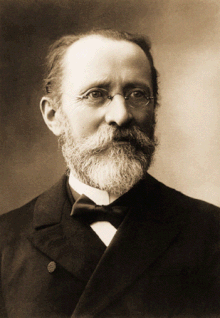Vojtěch Šafařík

Vojtěch Šafařík (26 October 1829 in
The crater
Work
In
In 1859, together with fellow chemist
In 1860, Šafařík published the first introductory university textbook of chemistry in Czech (Základové chemie čili lučby). He worked to improve Czech chemical terminology, building on and improving over the nomenclature of Czech chemist Jan Svatopluk Presl and the linguist Josef Jungmann. In 1882 he was appointed as the first professor of chemistry at Charles-Ferdinand University in Prague.
In later life, he wrote many popular textbooks as well as making over 20,000 observations of variable stars. His wife and co-worker Paulína Šafaříková[2] was interested in the history and popularisation of astronomy.
Note
Vojtěch Šafařík's name has often been incorrectly recorded as Adalbert Šafařík. It is thought that the confusion arose because of misguided translation attempts.
Safarik himself contributed to the confusion. His written astronomical works are signed either "A. Safarik" or "Adalbert Vojtech Safarik" as can be seen from the Astrophysics Data System listing all his papers.[3]
See also
References
External links
- Biography: http://www.vscht.cz/skola/historie/safarik (Czech)
